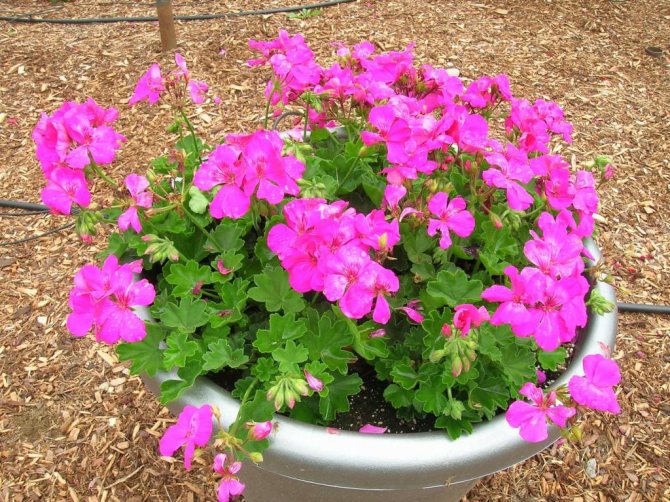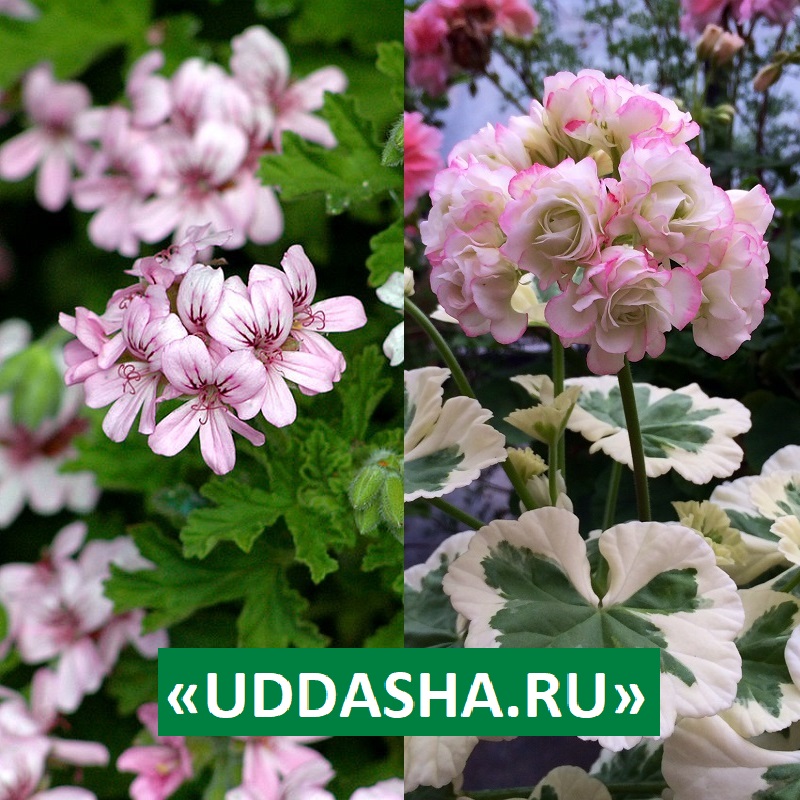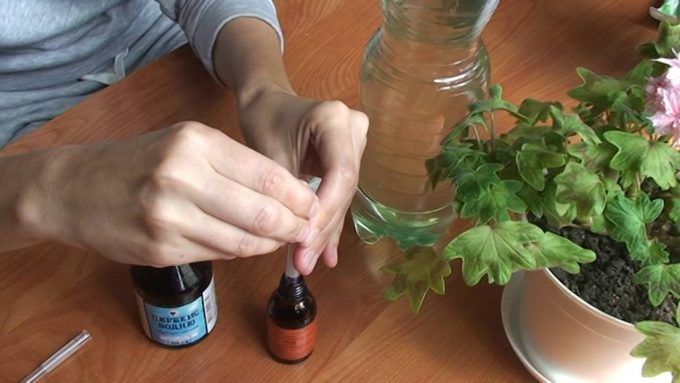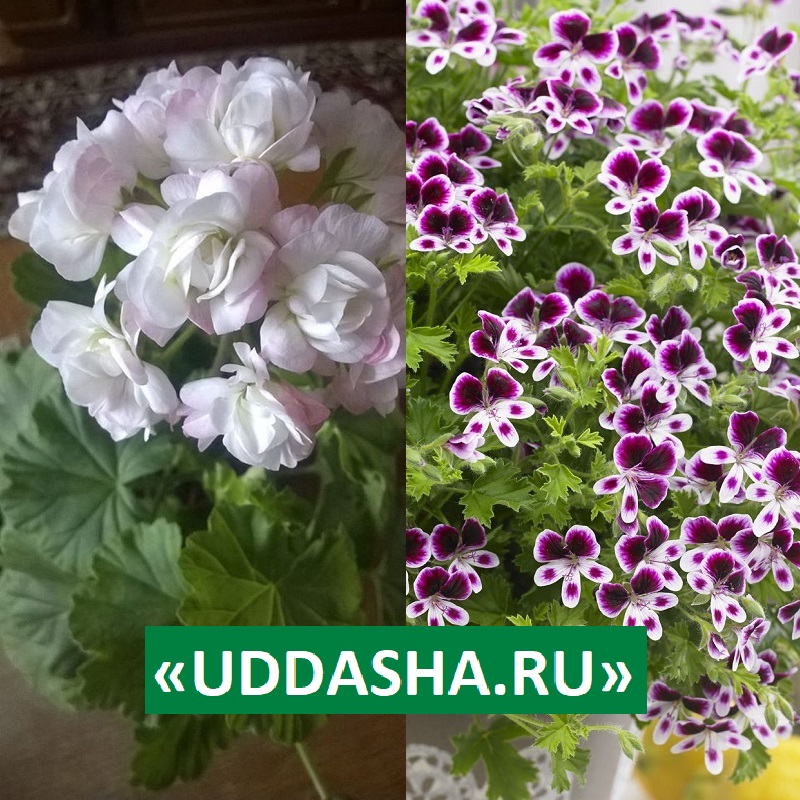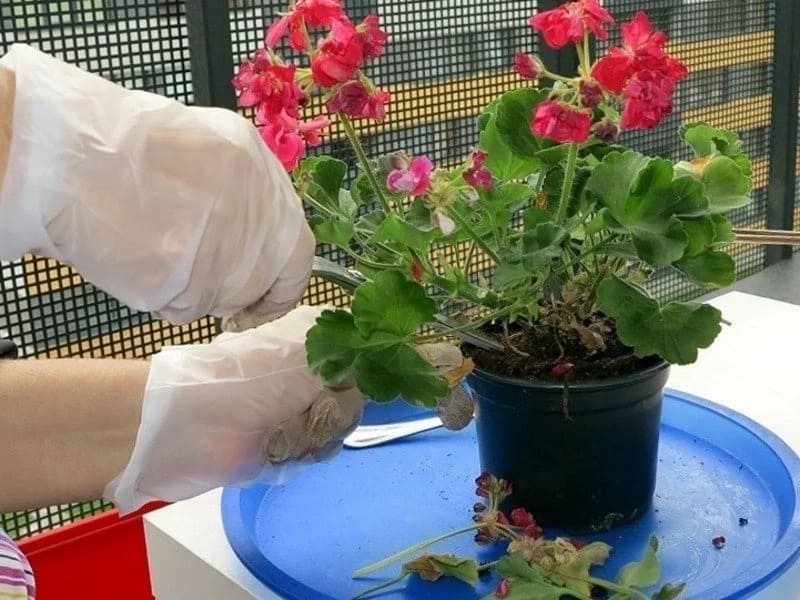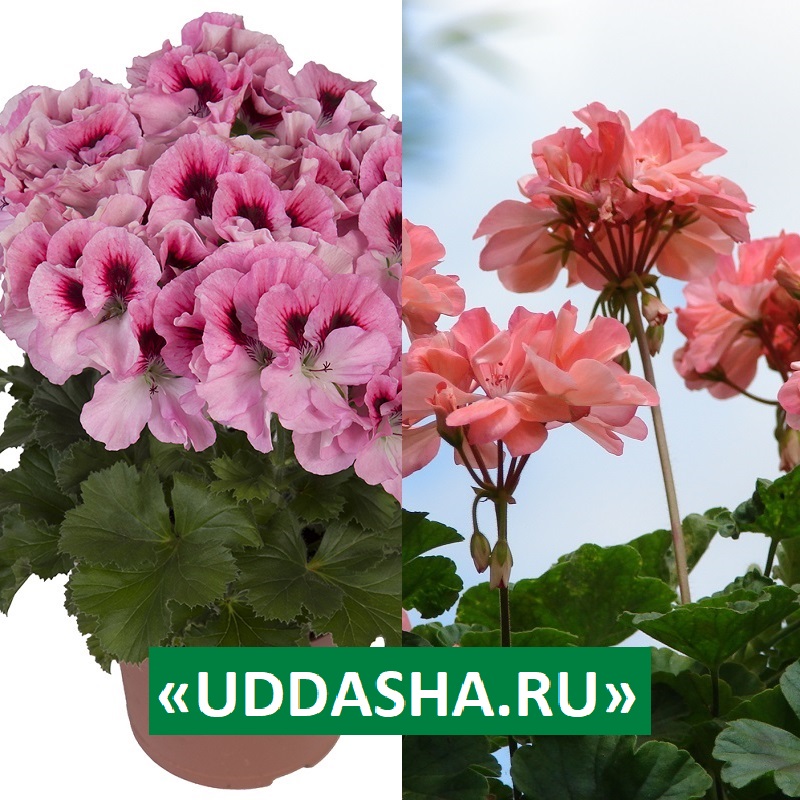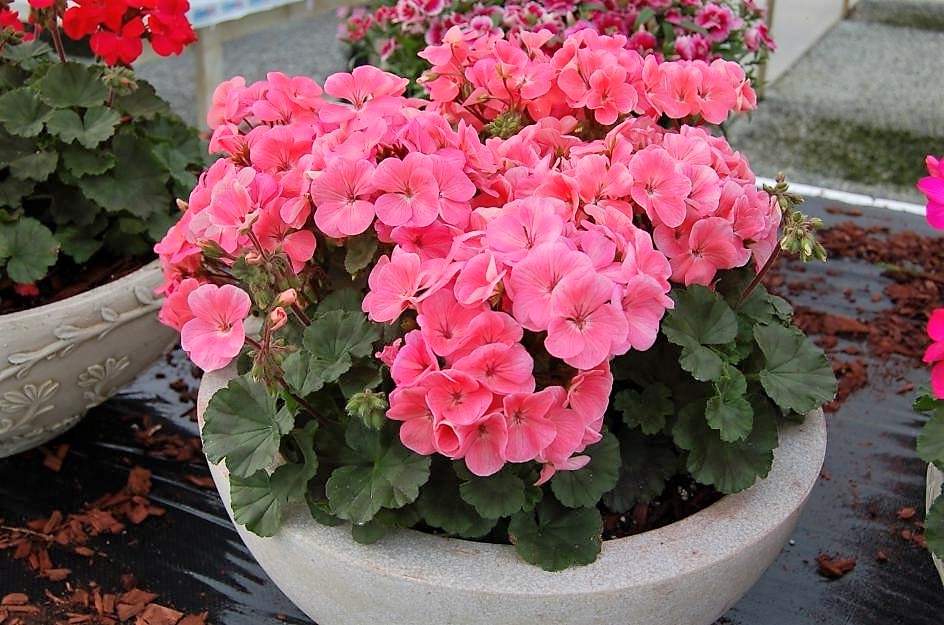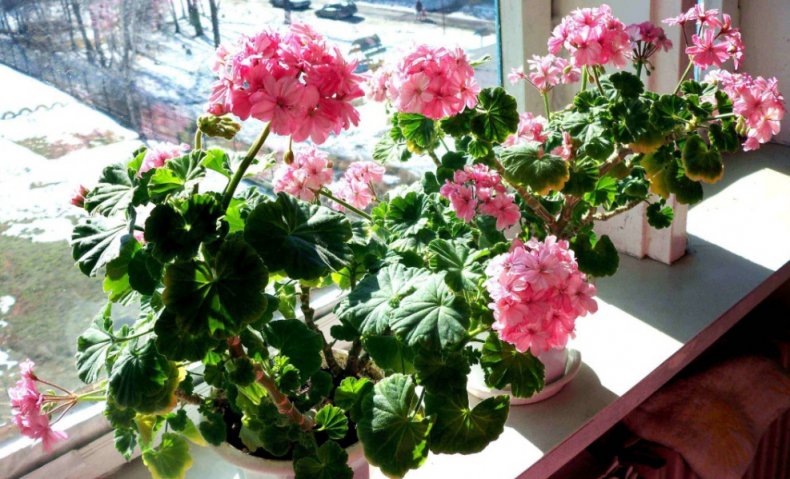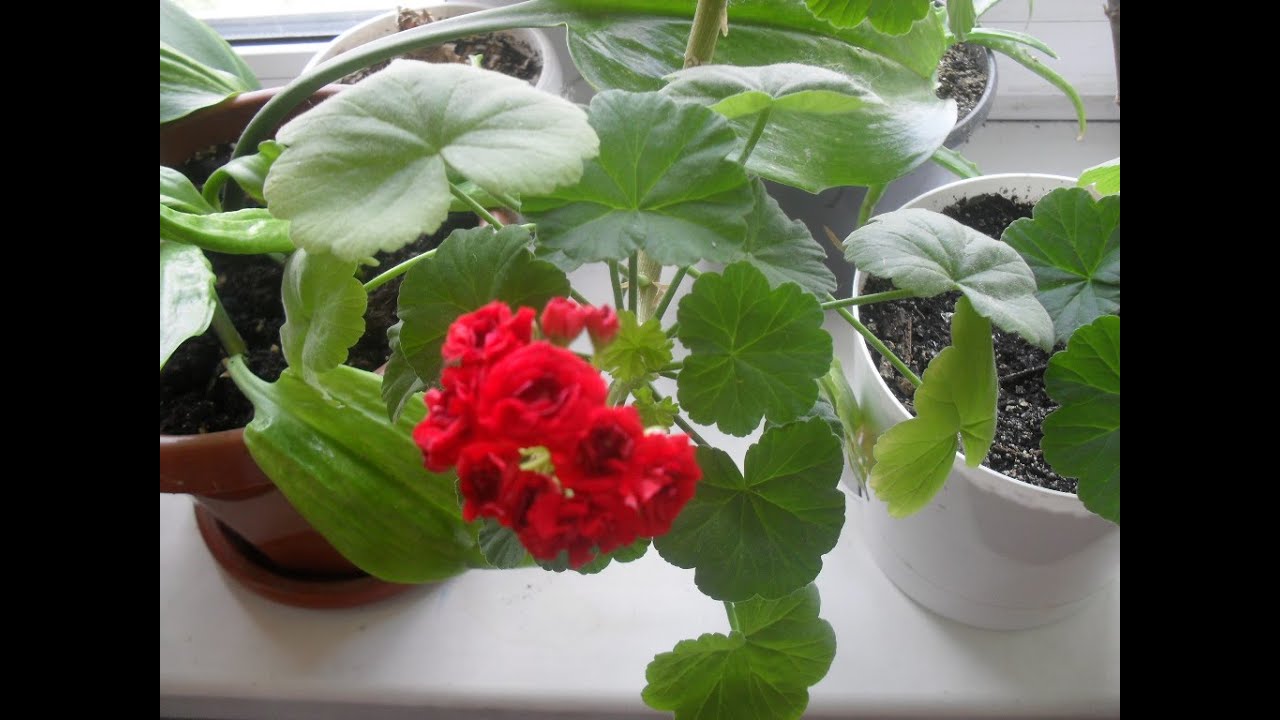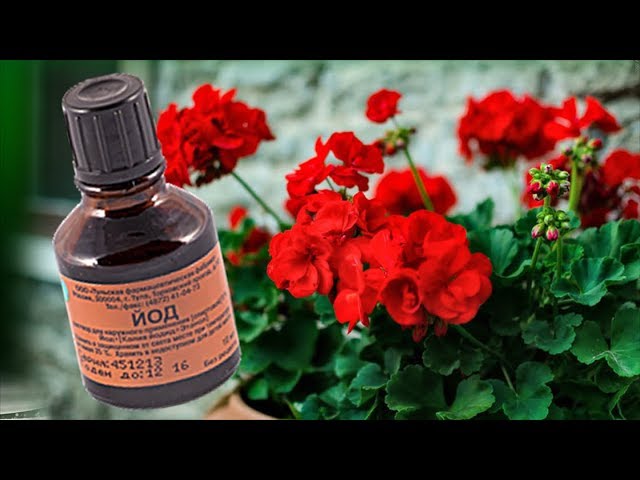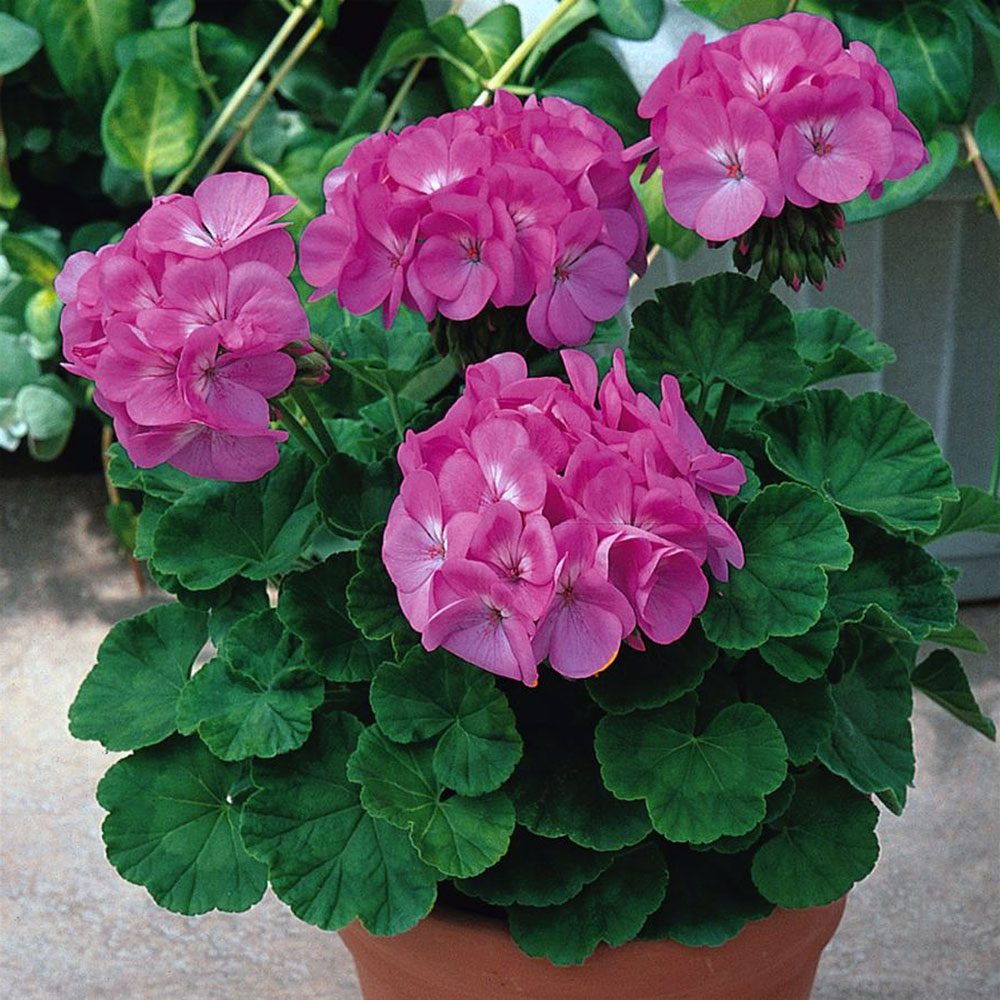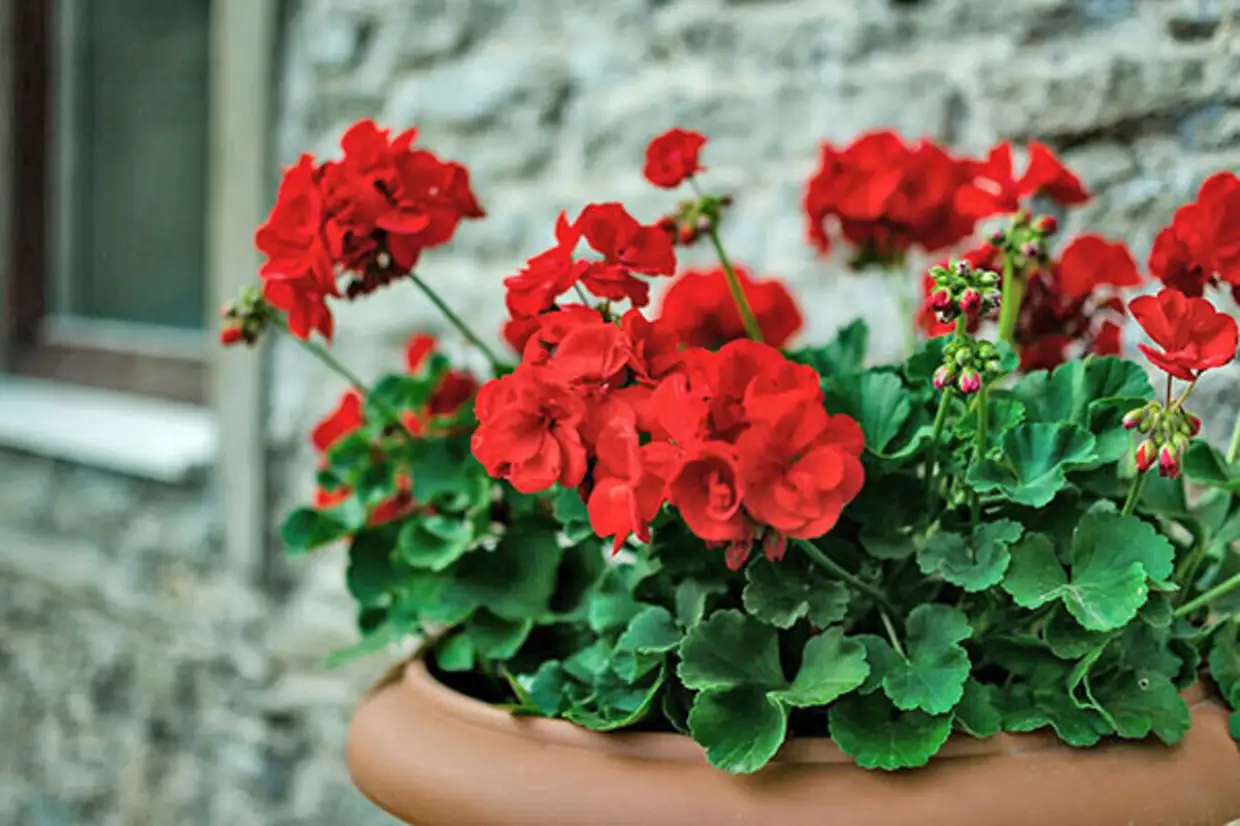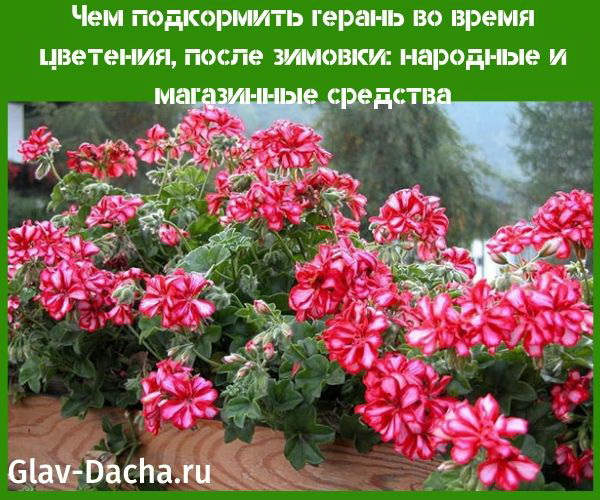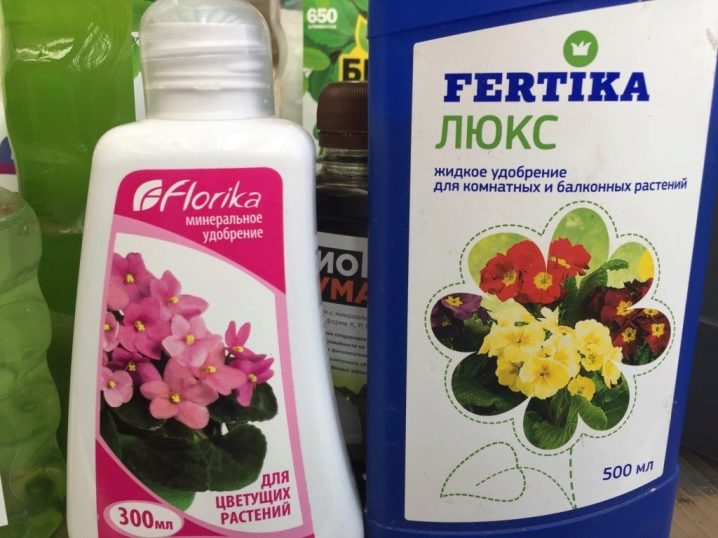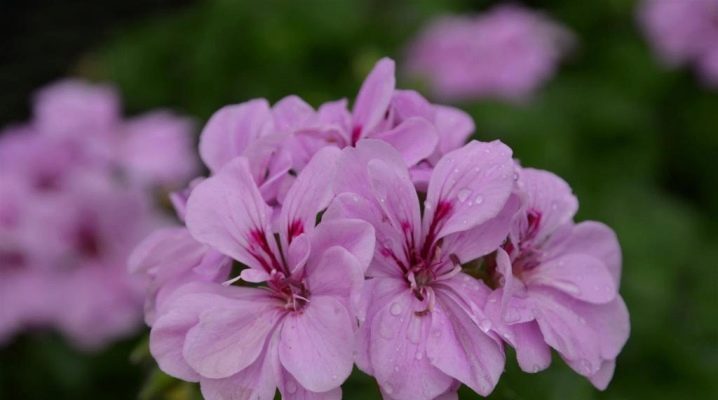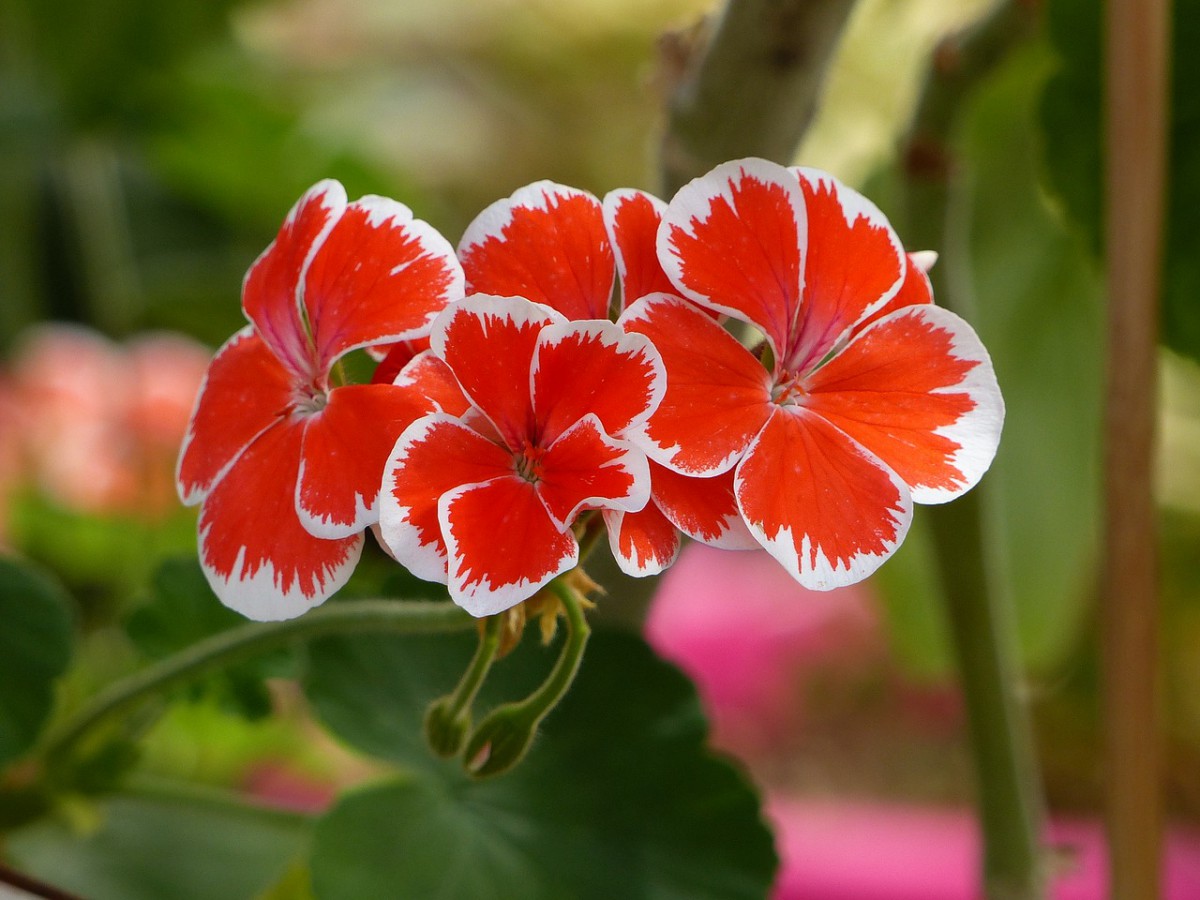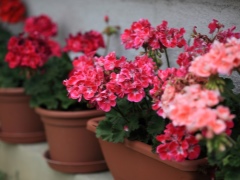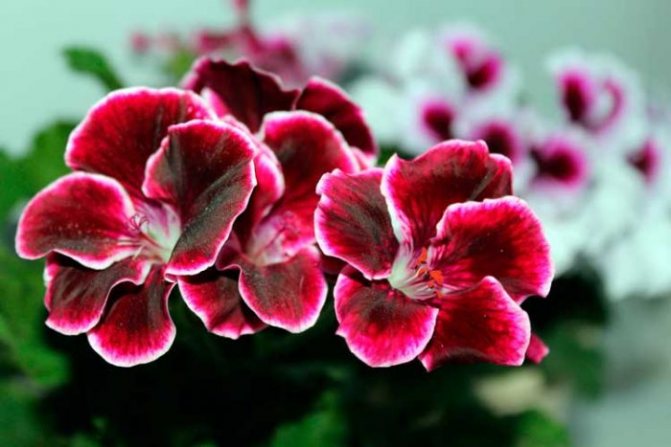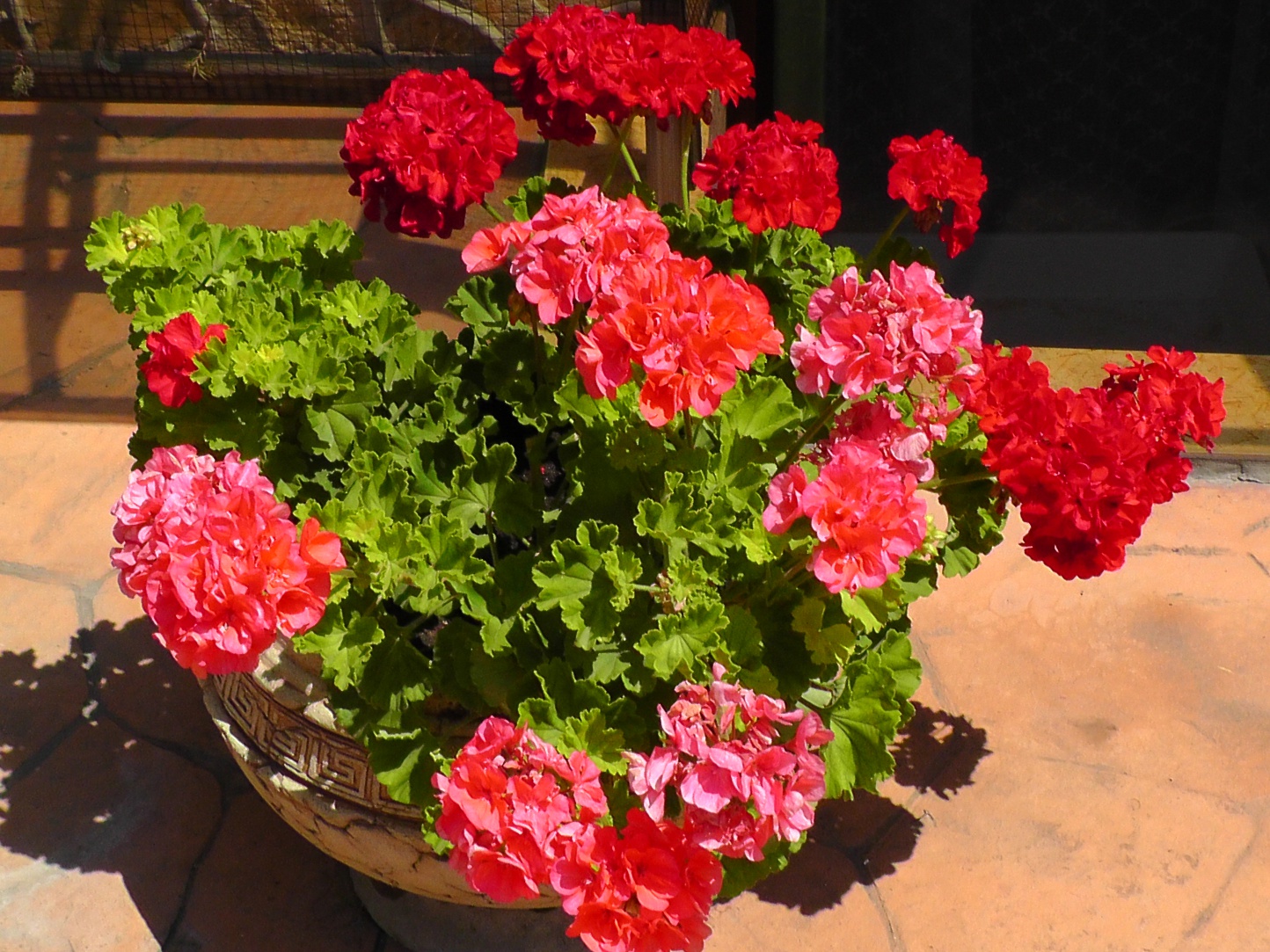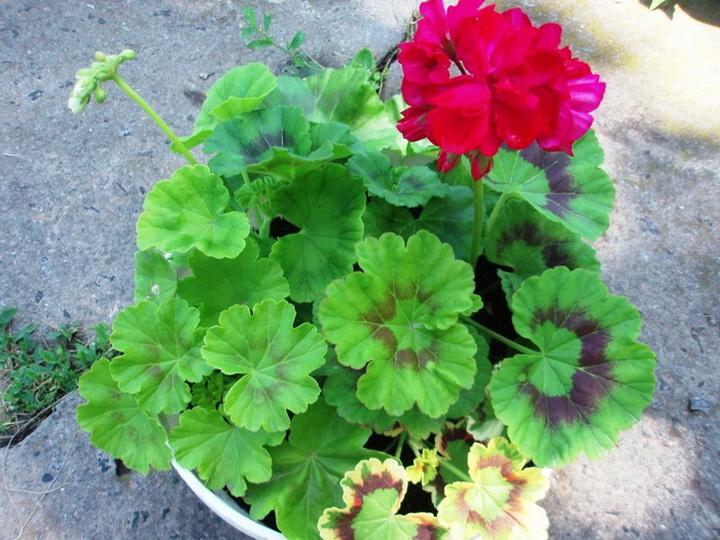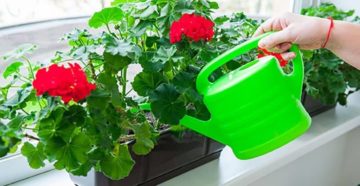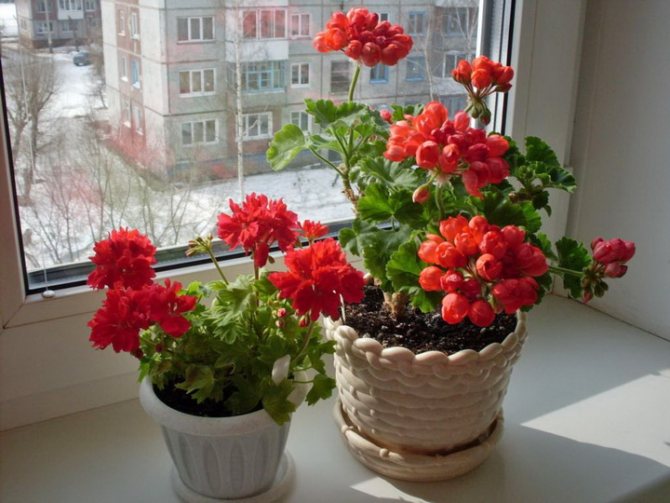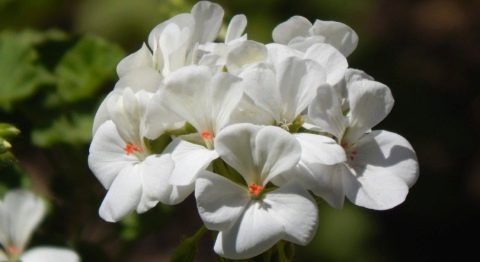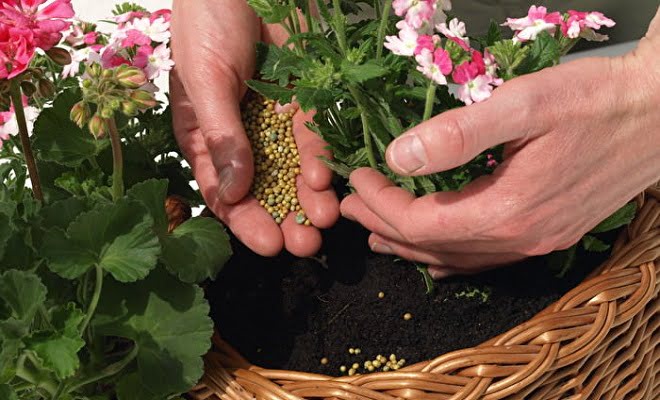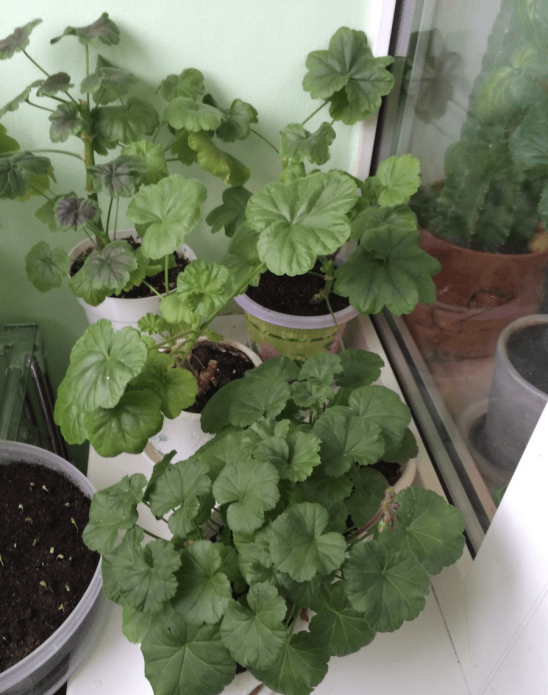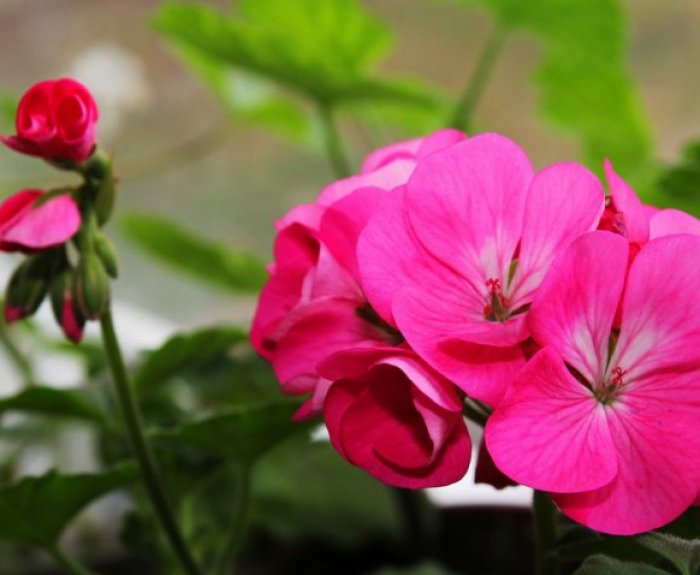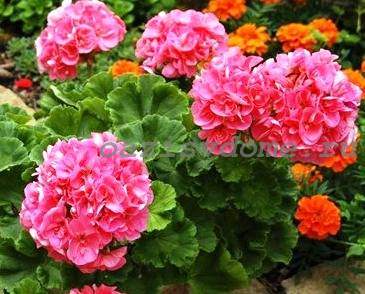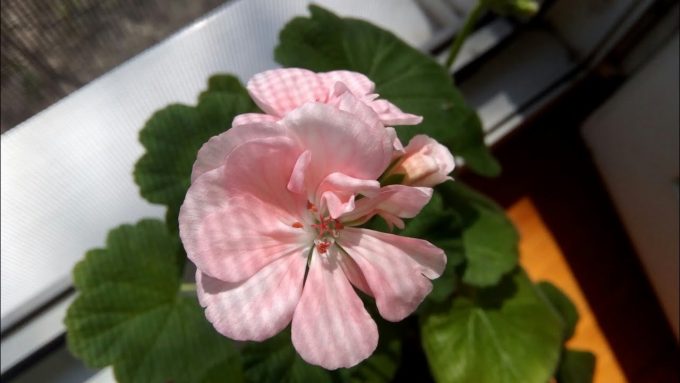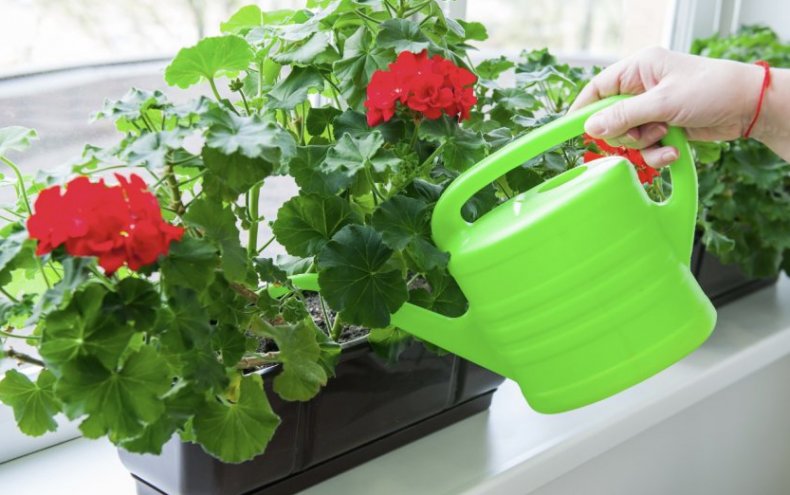What is geranium iodine for?
The number of flowers will increase if you feed the plant with magnesium sulfate a couple of times during the summer. But most growers choose a different method. They mix two ingredients: regular drugstore-bought iodine and hydrogen peroxide.
A solution of three elements (the third is water) weakened or unwilling to bloom geraniums are watered once every 7 days.
The described solution is very useful for an indoor flower. It strengthens the root system significantly. Strong roots provide the plant with nutrition, which is immediately visible: the leaves become larger, their color is brighter.
It is impossible not to notice how the appearance of the flower changes:
- his colors are saturated;
- the appearance of ovaries is accelerated;
- the number of buds increases;
- flowers are enlarged;
- the flowering period is extended.
Like real "living water", the mixture works wonders. It destroys bacteria appearing on the plant, helps to overcome diseases, protects the root system from decay. The flower, fertilized with iodine, transforms, shows all its advantages, all the brightness of colors, all the tenderness and irresistibility.
It is not worth using such fertilizer too often. If the plant is doing well, you can be content with the usual watering.
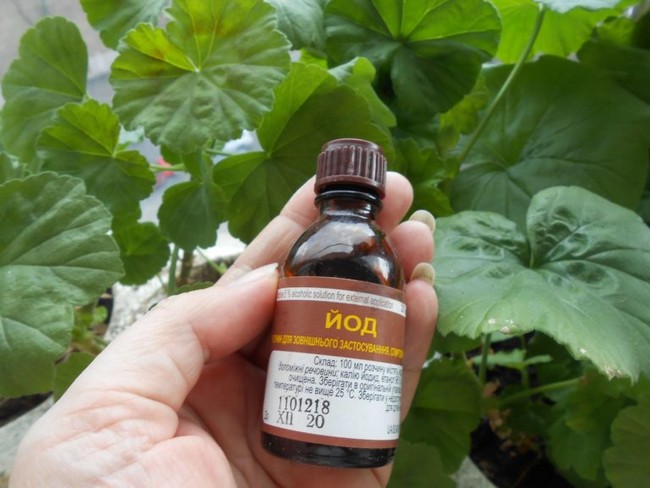
How to prepare fertilizer?
Medical iodine is used as a fertilizer for plants - an alcohol solution of iodine 5%. The recipe for the solution is simple - add one drop of iodine to a liter of water and mix thoroughly. It is advisable to use water or rainwater.
You can not use iodine in its pure form for watering geraniums. For very weakened flowers, the iodine concentration can be increased to 3 drops.
Watering
Here's how to properly water a flower:
- Prepare a solution.
- Pour the soil with plain water.
- About an hour after the water has been absorbed into the soil, gradually pour in the iodine solution.
Pour the iodine solution as close as possible to the side wall of the pot. On average, one flower pot requires 50 ml of solution.
Frequent feeding with iodine can damage the root system. It is advisable to do such watering no more than once a month. if something went wrong ...
Iodine dressing often falls on the foliage of the plant.
If you do not pay attention to this and do not take action, the leaves will wither and dry out.
Attention! If the solution with iodine gets on the leaves, you must immediately remove it with a soft cloth.
An excess of iodine can negatively affect the room beauty - lead to her violent flowering and the appearance of a yellow color in buds and leaves.
Even beginner growers can achieve abundant and beautiful flowering of geraniums.
It is important not to forget about feeding the plant. Such a valuable trace element as iodine is an excellent activator of the life processes of indoor plants.
But it is worth remembering that not only watering with iodine solution is necessary for a flower, but also fertilizing with mineral fertilizers.
Want to know more about growing geraniums at home and outdoors? Read our expert articles on how to prune and pinch your plant, how to choose the soil and pot, and learn tips for caring for a flower in the winter.
Description of the plant
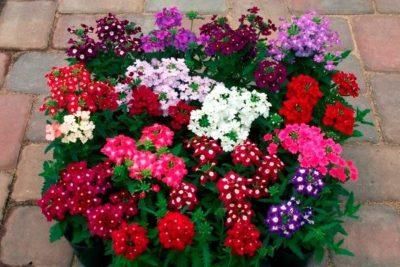 It is an annual and perennial plant. The height of the stems reaches 50 cm. The leaves are of a bright dark green color. The flowers of the plant are very beautiful and large. In some geranium species, they are collected in inflorescences. The leaves of the culture have a refreshing, mint and lemon scent. There is a pattern on the leaves, presented in the form of a white border or stripes of various colors.
It is an annual and perennial plant. The height of the stems reaches 50 cm. The leaves are of a bright dark green color. The flowers of the plant are very beautiful and large. In some geranium species, they are collected in inflorescences. The leaves of the culture have a refreshing, mint and lemon scent. There is a pattern on the leaves, presented in the form of a white border or stripes of various colors.
Geranium is distinguished by incredibly beautiful flowering.Umbrellas of flowers are concentrated on a thin stalk, and the leaves look like a human palm. If the geranium does not have enough lighting, then its flowering decreases, and the leaves and flowers become faded.
What fertilizers are needed for the lush flowering of geraniums
For abundant flowering, pelargonium needs to be fed with mineral fertilizers. One-component feeding is required:
Nitrogen promotes the growth of the vegetative part of the plant - stem, leaves, roots. It is used in the first months of spring. Phosphorus is required for bud formation. Its lack slows down the process. Potassium increases endurance. With its lack, growth stops.
During the blooming of the buds, the amount of nitrogen is reduced, and the amount of potassium is increased. You can also use complex fertilizers, which contain many minerals. Useful for geraniums:
These minerals are an additional source of strength for its good growth. Thanks to sulfur, magnesium, it will bloom regularly. All substances should be applied in accordance with the attached instructions. Iodine is one of the most essential elements for pelargonium. It is essential for lush flowering.

Tips for florists:
- Fertilizers in liquid form can be used only after watering, as there is a possibility of burns to the roots of the plant.
- After adding minerals, the soil under the flower must be loosened.
- Pelargonium should not be fed 2 weeks before transplant, and 1 week after.
- The flower has buds - it cannot be disturbed, transferred to another place. It will be stressful for her.
- Patients with pelargonium cannot be fertilized.
There are many ways to feed geraniums at home. The two most famous are:
- with the addition of iodine, peroxide;
- with the use of pharmacy vitamins.
Top dressing with iodine and peroxide
Ordinary iodine from the first aid kit can cause rapid flowering of pelargonium. The process does not take long, but it gives good results. After such fertilization, the effect can be seen after 2 - 3 procedures.
How to water geranium with iodine:
- It is required to moisten the soil in the pot.
- It is necessary to make a solution. Proportions - 1 drop of iodine per 1 liter of water. 1 ml of hydrogen peroxide can be added to this solution.
- Watering - along the edges of the tank walls. Avoid getting liquids on the leaves. For 1 procedure, you can use 50 g of solution.
- The number of dressings is 1 time per 3 weeks. It is often not recommended to use it - it will damage the roots.
- Time - May - September. This must be done very carefully. Excessive amounts of solution components can burn the roots of the flower.
Video: How to feed geraniums with iodine
Water for the preparation of folk dressing must be settled. Rainwater is ideal.
Vitamins
Fertilizer for geraniums to bloom can be purchased at the pharmacy. In addition to iodine, B vitamins are used for geraniums - B1, B6, B12. This is a folk remedy, one of the budget methods.
In the first months of spring, it needs nitrogen. Vitamins begin to be used closer to June. For one time, 1 ampoule of vitamin is used per 2 liters of water. Water the flower abundantly. Vitamins are changed every 3 weeks. Pelargonium can bloom well without fertilization. The main thing is not to overdo it. An excessive amount of introduced substances can destroy it. Such feeding of pelargonium gives it the opportunity to bloom profusely, enhances the defenses of the plant.
Organic feeding
Feeding of animal or plant origin for geraniums is required every 3 years. If you have a question of how to feed geraniums to bloom better, you should give preference to minerals.
In order for geraniums to bloom magnificently, it can be watered with well-acidified bird droppings (1 liter for 2 buckets of water), cow dung (1 liter for 1 bucket of water). It is not recommended to use fresh manure.
If you have a choice between chicken dung and mullein, it is better to choose the second option - it is more gentle. The lush bloom of geraniums is provided by minerals. Almost no organic matter is required.
At the beginning of May, nitrogen is introduced into the soil, at the end - complex fertilizers for flowering plants. They use vitamins, increase the volume of potash and phosphorus fertilizers.
She can tolerate mild drought. But excess moisture will destroy it. The feeding period is March - September. The soil must be moist. At the time of illness, if the plant has stood for a long time in the sun, fertilizers cannot be applied.

You will also be interested to read:
Highlights to watch out for
Pelargonium, like any other flower, loves something, but something does not. For example, it grows well in the sun. Not a problem for her, and a light shadow. She is able to survive small autumn frosts, but at the same time she loves warmth very much. She needs rare, while abundant watering with water. It will not do without good drainage in the container where it is planted. If the soil is scarce, then there will be fewer flowers. Otherwise, there will be a lot of greenery on the sprout. She cannot do without fertilization. Do not forget about such a drug as iodine.
In order for the sprout to bloom better, remove the inflorescences that have faded. When fertilizing, observe the measure. So, without causing harm, you can contribute to the good growth of pelargonium. By observing these simple rules, you can ensure a long life for your beloved home flower. This way you can enjoy its bloom for a very long time. This will create a pleasant, cozy atmosphere in your home. After all, beautiful flowers always decorate the interior.
And a little about the secrets of the Author
Have you ever experienced unbearable joint pain? And you know firsthand what it is:
- inability to move easily and comfortably;
- discomfort when going up and down stairs;
- unpleasant crunching, clicking not on their own;
- pain during or after exercise;
- joint inflammation and swelling;
- unreasonable and sometimes unbearable aching pain in the joints ...
Now answer the question: does this suit you? How can you endure such pain? And how much money have you already "poured" on ineffective treatment? That's right - it's time to end it! Do you agree? That is why we decided to publish an exclusive interview with Oleg Gazmanov, in which he revealed the secrets of getting rid of joint pain, arthritis and arthrosis.
Attention, only TODAY!
You can also grow geraniums from seeds, but I prefer cuttings, which are carried out from mid-February to early March. At this time, it is already required to prune geraniums.
After all, geranium is photophilous, and in winter there is little light, and the plant stretches out, becomes not very beautiful. In geraniums, you need to cut off the bare shoots to the height that you need, new branches will go from them.
A drop of iodine - and you won't recognize your geranium!
And you can renew the geranium every year by replanting from a new cuttings, as our great-grandmothers did in the old days. For propagation of geraniums, apical cuttings about 7 cm long with three or five leaves are suitable.
Cut the cuttings, making an oblique cut under the bud, cut off the bottom pair of leaves, dry the cut and the place where the leaves break for 2 - 3 hours, so that the cut is tightened with a film, and plant immediately in prepared pots with soil, lightly water.
To form a lush bush, pinch the apical bud. We put in a bright place, but not in the sun.
Many simply cut the cuttings and put them in water, I advise you to put activated carbon tablets in a jar of water so that there is no decay. Roots form very quickly. Then they are placed in pots.
You need to take a small pot. You don't need a lot of geranium land. The faster the roots cover a clod of earth, the faster the plant will bloom, and the smaller the pot, the more abundant the flowering will be. In large pots, the plant may not bloom at all, it does not need it - life is so good, why bother? You can even plant several cuttings in one pot.
To form a beautiful lush bush, pinch the top on 8-10 leaves, the side shoots - on the 6-8th and constantly turn the pot so that the bush is even.
Geranium likes:
- the sun (but also tolerates a light shade);
- warm (but will survive very light autumn frosts);
- not frequent, but abundant watering;
- good drainage in the pot;
- moderately fertile, even poor soil (otherwise there will be a lot of greenery, but few flowers);
- regular feeding;
- removal of faded inflorescences to continue flowering.
Iodine water is a very good top dressing: dissolve 1 drop of iodine in 1 liter of water and pour 50 ml of this composition along the walls of the pot. Do not overdo it so the roots do not burn! After such watering, geraniums bloom continuously and gorgeous!
If the leaves turn yellow, the reasons may be as follows:
- if only the edges of the leaves dry out - the reason is a lack of moisture;
- if the leaves are lethargic or rotting - the reason is excess moisture.
In summer, geraniums are very fond of living in the fresh air - take it to the balcony or garden, plant it well in the ground. At first, having gone through the stress associated with a change of place, geranium will hurt, its leaves may turn yellow and fall off. But then she will delight you with abundant flowering.
On the street, geraniums bloom amazingly, and the bush grows strongly like never before at home. In the sun, sometimes geranium leaves turn pink - this is a normal phenomenon, like a "tan", the plant is no better, no worse.
In autumn, when the weather is cool at 10-12 degrees, geraniums "go crazy" from such a temperature!
You can keep geraniums outside until the frost begins, until the temperature drops to +2 -5 degrees. Then it will need to be cut, transplanted into pots and placed in a cool place (10-12 degrees) for hibernation, or, gradually accustoming it to a higher temperature, brought into the room where it will continue to bloom.
Pinching and pruning geraniums at home
How to properly pinch pelargonium at home
Pinching (pinching) - removal of the upper part of the plant with young shoots. This slows down the apical growth and stimulates the branching of the lower lateral shoots. Pinch with clean fingers.
You need to pinch the plant from the very beginning of its development.
Especially important for seed-grown geraniums
Pinching pelargonium
It is done in several stages.
First you need to pinch the apical bud of the main shoot above the stem node. The lateral buds located below wake up after this procedure and begin to grow and lengthen.
The next stage is pinching the tops of the ivy-leaved side shoots until the bush acquires the desired shape. If you do not do all this at the very beginning of plant growth, then there is a high probability of getting an ugly plant with a long bare stem and a small number of flowers located at the very top.
It is geranium that differs from many flowers in that it gives lateral shoots after the forced awakening of dormant buds in a node, if forced.
How to prune for a lush bloom and fluffy crown?
Pruning is the removal of some of the shoots that have stem nodes.
Autumn pruning is carried out at the end of the growth period. This condition allows you to form a lush and fluffy crown.
If the flowers were outside in the summer, then they must be brought into the house before cutting the indoor pelargonium. Make sanitary pruning by removing damaged, diseased shoots. To ensure good ventilation, cut the shoots directed towards the inside of the crown, shorten the stems by a third.
So that the shoots after waking up do not interfere with each other, you need to prepare them and cut them at an angle above the leaf node, which is located outward. A clean, sharp knife or blade is suitable for this purpose.
In winter, the dormant period for geraniums. Frequent watering is reduced and feeding stops completely. The air temperature should be no more than 10-12 degrees.Water and feed as recommended.
Spring pruning comes down to the final formation of the bush. You can start it from the end of February or early March. At this time, the active growing season begins. If you are late with the dates, then the flowering period will be postponed.
Why fertilize?
Top dressing is an important process in growing a plant, thanks to which it is saturated with useful components for active growth and flowering.
When applying top dressing, take into account the season:
- in spring and summer, fertilizer is applied once every 2 weeks;
- in winter - no top dressing is used (it is allowed to add only ½ of the usual dose of stimulants in the middle of winter months).
Important! The choice of drugs must be considered carefully. The fact is that geranium will not tolerate organic matter.
For its flowering, mineral fertilizers are used, the main of which are nitrogen, phosphorus and potassium.
They must be added in equal proportions, but by the beginning of flowering, the nitrogen dosage decreases, but the potassium concentration increases.
If it is impossible to apply fertilizers separately, then it is worth using ready-made mineral sub-crusts. They contain additional minerals
Particular attention must be paid to iodine, to which the plant responds with abundant flowering.
It is not worth making liquid dressings without preliminary watering the soil. Otherwise, the roots will burn and die off. It is necessary to apply fertilizers for geraniums one hour after the main moistening.
When do you need to feed?
Before proceeding with feeding and considering possible methods, it is worth determining when the plant needs it. This can be determined by the features that are noticeable in a complex manifestation.
If geranium becomes vulnerable to disease, then this is the first signal that it lacks nutrient minerals in the soil. Because of this, the flower is often sick, as there is a lack of nutrients in the body.
But here it is important not to overdo it with feeding. Too often for geraniums is unacceptable
You can determine the lack of nutrients by the leaves. They become lethargic, pale, and their growth slows down. If the flower is affected by diseases, then the leaves begin to dry out. With a severe form of the disease, the leaves crumble.
Geranium will bloom only if two important conditions are met:
- correctly selected temperature mode;
- top dressing, which has all the necessary nutrients.
If these conditions are not met, then the culture will not bloom for years. There are no buds on geraniums if they are not fed correctly. Apply fertilizer every 2 weeks in spring, and once a month in summer and autumn. Before applying top dressing, you need to water the soil with water. This will prevent the development of root burns.
You can find out more about when to use fertilizers and how to feed them better here.
What can you use?
Attention. When choosing a fertilizer, it should be borne in mind that in specific periods of geranium development, a different concentration of minerals in the composition of fertilizing is required .. If at the beginning of spring the proportions of nitrogen, phosphorus and potassium can be equal, then after the green mass is built up, the percentage of nitrogen is minimal
During this period, it is necessary to use fertilizers containing potassium and phosphorus, which affect flowering.
If at the beginning of spring the proportions of nitrogen, phosphorus and potassium can be equal, then after the green mass is built up, the percentage of nitrogen is minimal. During this period, it is necessary to use fertilizers containing potassium and phosphorus, which affect flowering.
The next important trace element, which is necessary for the abundant flowering of geraniums, is magnesium sulfate. It is necessary to add it 2-3 times in the summer so that the flowers acquire a rich color, the number of buds increases, and the flowering period will last.
To stimulate the growth of the culture, you can water it once a week with an iodine solution (1-2 drops per 1 liter of water).The components contained in iodine strengthen the root system, and this has a positive effect on the appearance of geraniums.
More details about how to feed geraniums for lush flowering can be found in this material.
The importance of proper fertilization
The correct choice of fertilizer for pelargonium is the key to a healthy plant and abundant flowering. Organic fertilizers solve part of the problem.
Pelargonium is an important complex of minerals such as potassium, nitrogen and phosphorus. The proportion of nitrogen is reduced closer to the flowering period with a simultaneous increase in the amount of potassium. Pelargonium responds well to the addition of iodine before flowering.
When and in what cases top dressing is required?
Pelargonium is hibernating in winter. For this reason, no additional food is needed. They begin to apply fertilizers in spring and continue throughout the summer. The introduction of complex fertilizers 2 times a month will provide the plant with nutrients in full.
Important! Fertilizing before watering is prohibited. The roots of the flower will burn and die
Top dressing is added after watering with water after one hour.
Situations in which feeding is not performed:
- in case of flower disease;
- after prolonged exposure to the sun;
- 2 weeks before and a week after transplant.
How and how to fertilize?
The main purpose of plant nutrition is lush and long flowering. The use of nitrate, phosphate, potassium and iodine-containing substances will help to achieve the goal.
A complete nutritional "diet" includes:
- iron preparations;
- sulfur;
- potassium permanganate;
- magnesium-containing substances;
- calcium.
Ready formulations
Fertilizers in finished form are found in dry and liquid form. Pokon products are popular with flower growers.
When using them, the growth and flowering of pelargonium is accelerated. You should not be zealous with fertilizers, which contain a large proportion of nitrogen.
This will lead to abundant foliage growth and the formation of powerful shoots, preventing the onset of the flowering process.
Hydrogen peroxide
Monthly use of hydrogen peroxide:
- disinfects the soil;
- prevents root decay;
- saturates the soil with oxygen;
- accelerates the formation of buds.
Reference! Dissolve 50 ml of the drug in 2 liters of water. The mixture is used for watering and spraying pelargonium.
Boric acid
The drug will help to increase the chlorophyll content in pelargonium and stimulate the flowering process. Top dressing is carried out during the active growth phase at the rate of 10 g of boric acid per 10 liters of water with the addition of 1 glass of ash.
Milk mixture
Adjustment of the flowering volume of pelargonium is carried out by alternating watering with ordinary water and milk solution. Prepare a solution of 1/2 glass of milk and 1 liter of warm water.
Sugar
Pelargonium responds positively to sugar feeding. The addition of a sugar solution during the winter will make the plant bloom. The frequency of feeding with sugar once a week. To obtain a sugar solution, take 2 tablespoons of sugar per 1 liter of water.
Ash
The addition of ash disinfects the soil and forms beautiful buds. Top dressing is prepared from 40 grams of ash and 1 liter of water. The frequency of "feeding" is once every two weeks.
Yeast
Dry yeast is diluted in warm water at the rate of 1 gram of the drug, 20 grams of sugar and 1 liter of water. After the start of fermentation, dilute with water in a ratio of 1: 5. Such feeding will form a massive and healthy pelargonium.
Important! Top dressing should be done only in spring. No more than 2 times per season.
How to feed for abundant flowering?
Abundant flowering is facilitated by the introduction of mineral fertilizers:
- nitrogen;
- potash;
- phosphoric;
- iodine.
Nutrient Blend Options for Lush and Long Lasting Blooms:
- Wood ash and water. A solution of 20 grams of ash and 1 liter of warm water will increase the number of buds.
- Vitamins of group B. An increase in the number of buds when using vitamins is achieved by alternating dressings:
- the first using B1;
- three weeks later, the second — B6;
- three weeks later, the third is B12.
A solution is prepared from 1 ampoule of vitamin and 1 liter of water. The composition is watered along the edge of the pot, around the root system.
- Magnesium sulfate solution. Dissolve 1.5 tablespoons of the drug in 10 liters of water.
Iodine
Iodine can provide vigorous flowering of pelargonium. The use of ordinary pharmaceutical iodine will not take much time, and the result will be good. The effect of iodine feeding is noticeable after 2-3 applications.
Algorithm for using iodine for feeding pelargonium:
- Pre-moisten the potting soil.
- Prepare a solution of 1 drop of iodine, 1 ml of hydrogen peroxide and 1 liter of water.
- Watering 50 grams of solution without touching the root system and leaves along the edge of the pot.
- Frequency rate of nutrient watering once every 3 weeks. Increased feeding will cause root damage and death.
- Start feeding in May and finish in September.
In the video about fertilizing pelargonium with iodine and peroxide:
A few tips for caring for geraniums
Geranium does not require much maintenance. But you still have to follow a few rules:
- Watering. It is necessary to ensure that the soil in the pot is always moist. But when planting a flower, it is imperative to provide a drainage layer. If this is not done, the water will begin to stagnate, which will cause the development of putrefactive processes in the root system and the death of the plant. With insufficient watering, metabolic processes in flower cells proceed incorrectly, the formation of buds stops.
- Geraniums need a constant source of ultraviolet radiation. Lack of sun affects the state of the flower: the shoots are stretched out, the leaves dry and fall off, flowering stops. It is recommended to place the pots on the windowsills on the south side.
- The temperature difference negatively affects the geranium. Flower immunity is reduced if the plant is in a draft. As a result, the flower begins to ache, ceases to resist pests.
How to plant and care for geraniums at home
Geranium is not demanding on self-care.
For planting it, a small container is chosen. In a large pot, the flower puts all its energy into root growth, which interferes with flowering. Multiple flowers can be planted in a large container.
The soil is not chosen very fertile. Fertile soil causes rapid growth of stems and leaves, which slows down the flowering process. You can use a mixture of sand, leaf, sod land, humus.
When planting, you need to use drainage: small pebbles, gravel, broken bricks, etc. There should be holes at the bottom of the container.
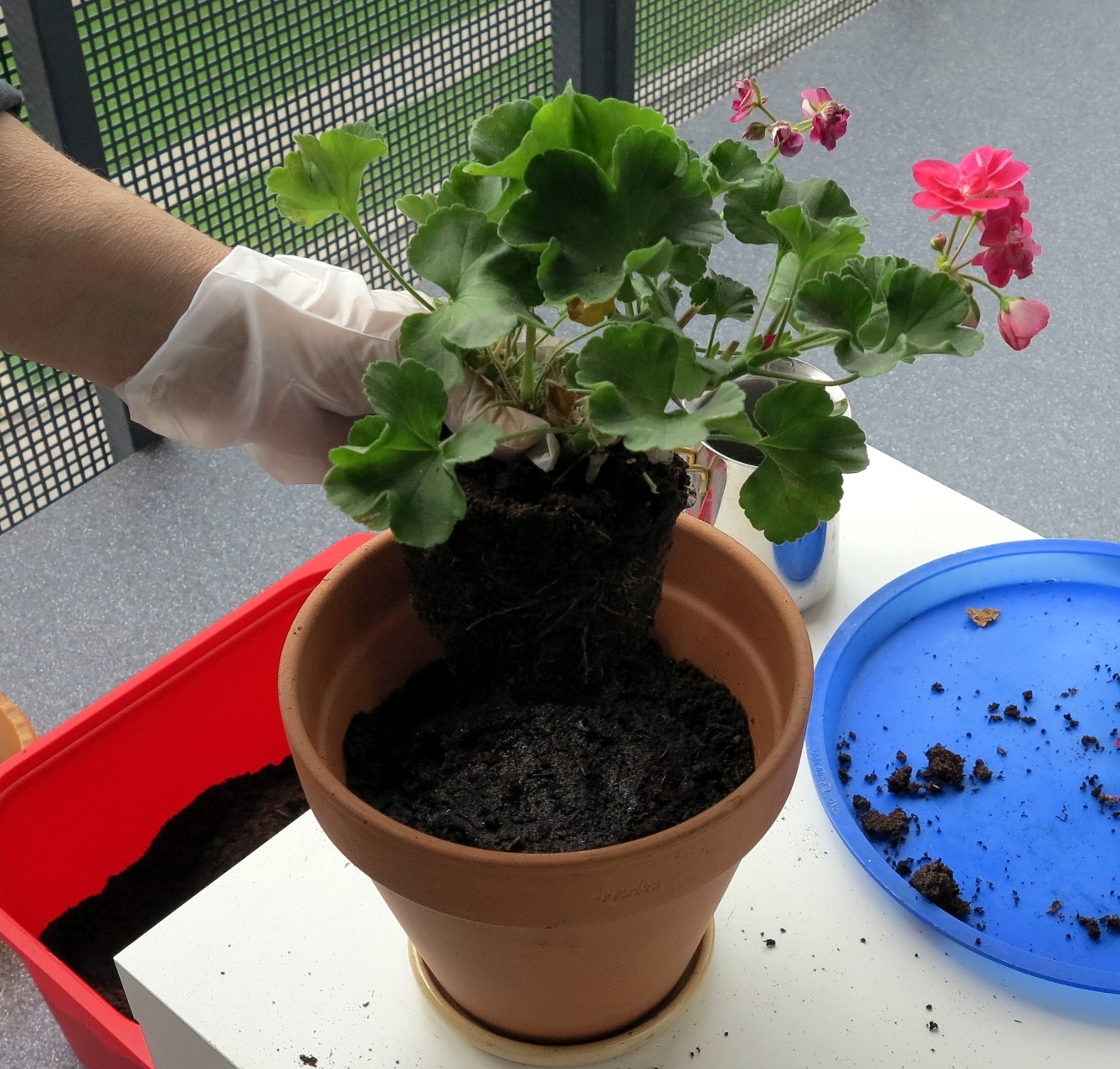
Transplanted, pruned once a year. If pruning is done closer to winter, the stem is shortened by 1/3. Without this, it is impossible to achieve lush flowering.
Geranium care includes:
Top dressing of geraniums is carried out only in the spring - summer period. This can be done 2 times a month, 1 hour after abundant watering. Fertilizers are not required in winter.
For its flowering, it is necessary to create favorable conditions:
- Adequate amount of sunlight - it is required to put on a windowsill on the south side;
- Not frequent, but plentiful watering - 1 time in 2 - 3 days;
- Timely feeding;
- Indoor temperature - not less than 20 о С;
- Well ventilated room.
Yellowed leaves or a wilting plant may be a sign of improper watering. The soil in the pot should be slightly damp. Do not overflow the flower. You do not need to spray the leaves.
Video: Proper care of geraniums
In winter, she is at rest. It must be transferred to a cool room - 10 o C. Daylight hours at this time should not exceed 5 hours. This promotes good flowering in spring.
Faded buds, dried leaves must be removed in a timely manner. In summer, pelargonium can be taken out onto the balcony, into the garden.
Planting and growing geraniums
The homeland of geraniums is South Africa, where the climate has a number of features. Thanks to this, the flower in question easily adapts to the living conditions.In order for the plant to please with flowering all summer, it is necessary to take into account the following factors:
- It is better to choose a light, loose soil with a neutral pH level for planting. It is good if the composition contains peat, river sand and humus.
- The pot should be small, otherwise the foliage and stem will intensively grow, and the process of bud formation will slow down. Drainage must be poured at the bottom: broken brick, pebbles or gravel.
- It is necessary to water the flower rarely, not abundantly. Drought is better tolerated by geraniums than excessive moisture.
The optimum temperature is + 15 / + 20 degrees. Also, we must not forget about pinching and pruning, because they contribute to the correct formation of the bush.

Why doesn't geranium bloom?
It often happens that geraniums, having extensive, juicy, green foliage, do not bloom for a long time. There may be several reasons for this:
- Inappropriate pot size. If the container in which the flower is planted is too large, then the plant puts all its strength into the development of the root system and the formation of deciduous mass. To fix this situation, you just need to change the pot for a more suitable volume.
- Unsuitable soil. The ideal soil for planting is a mixture of earth, sand, peat and humus. Once a year, the soil must be replaced with fresh, nutritious.
- Lack of light. Geranium prefers a well-lit place, but does not tolerate direct sunlight. The south or west side is perfect.
- Excessive soil moisture. Watering is rarely carried out, waiting for the top layer of the soil to dry. Do not allow water to stagnate in a pot or pan. An excess of moisture will lead to plant disease and the development of a fungus.
- Insufficient feeding. During the growing season, geraniums require additional nutrition. From March to September, it is necessary to apply fertilizers to the soil in a timely manner, otherwise you may not wait at all for flowering.
- High temperature and dry air. In the spring, it is advisable to take the pot with the plant to the balcony. The temperature difference between day and night activates the ejection of buds. It is better to cut off wilting flowers immediately, this will help prolong the flowering period.


